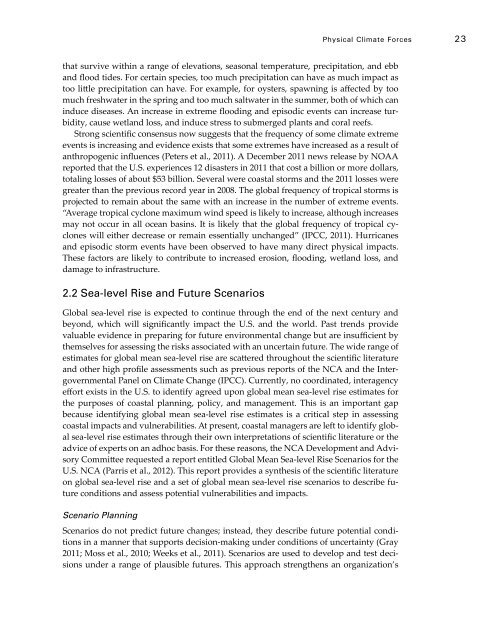Coastal Impacts, Adaptation, and Vulnerabilities - Climate ...
Coastal Impacts, Adaptation, and Vulnerabilities - Climate ...
Coastal Impacts, Adaptation, and Vulnerabilities - Climate ...
You also want an ePaper? Increase the reach of your titles
YUMPU automatically turns print PDFs into web optimized ePapers that Google loves.
Physical <strong>Climate</strong> Forces 23that survive within a range of elevations, seasonal temperature, precipitation, <strong>and</strong> ebb<strong>and</strong> flood tides. For certain species, too much precipitation can have as much impact astoo little precipitation can have. For example, for oysters, spawning is affected by toomuch freshwater in the spring <strong>and</strong> too much saltwater in the summer, both of which caninduce diseases. An increase in extreme flooding <strong>and</strong> episodic events can increase turbidity,cause wetl<strong>and</strong> loss, <strong>and</strong> induce stress to submerged plants <strong>and</strong> coral reefs.Strong scientific consensus now suggests that the frequency of some climate extremeevents is increasing <strong>and</strong> evidence exists that some extremes have increased as a result ofanthropogenic influences (Peters et al., 2011). A December 2011 news release by NOAAreported that the U.S. experiences 12 disasters in 2011 that cost a billion or more dollars,totaling losses of about $53 billion. Several were coastal storms <strong>and</strong> the 2011 losses weregreater than the previous record year in 2008. The global frequency of tropical storms isprojected to remain about the same with an increase in the number of extreme events.“Average tropical cyclone maximum wind speed is likely to increase, although increasesmay not occur in all ocean basins. It is likely that the global frequency of tropical cycloneswill either decrease or remain essentially unchanged” (IPCC, 2011). Hurricanes<strong>and</strong> episodic storm events have been observed to have many direct physical impacts.These factors are likely to contribute to increased erosion, flooding, wetl<strong>and</strong> loss, <strong>and</strong>damage to infrastructure.2.2 Sea-level Rise <strong>and</strong> Future ScenariosGlobal sea-level rise is expected to continue through the end of the next century <strong>and</strong>beyond, which will significantly impact the U.S. <strong>and</strong> the world. Past trends providevaluable evidence in preparing for future environmental change but are insufficient bythemselves for assessing the risks associated with an uncertain future. The wide range ofestimates for global mean sea-level rise are scattered throughout the scientific literature<strong>and</strong> other high profile assessments such as previous reports of the NCA <strong>and</strong> the IntergovernmentalPanel on <strong>Climate</strong> Change (IPCC). Currently, no coordinated, interagencyeffort exists in the U.S. to identify agreed upon global mean sea-level rise estimates forthe purposes of coastal planning, policy, <strong>and</strong> management. This is an important gapbecause identifying global mean sea-level rise estimates is a critical step in assessingcoastal impacts <strong>and</strong> vulnerabilities. At present, coastal managers are left to identify globalsea-level rise estimates through their own interpretations of scientific literature or theadvice of experts on an adhoc basis. For these reasons, the NCA Development <strong>and</strong> AdvisoryCommittee requested a report entitled Global Mean Sea-level Rise Scenarios for theU.S. NCA (Parris et al., 2012). This report provides a synthesis of the scientific literatureon global sea-level rise <strong>and</strong> a set of global mean sea-level rise scenarios to describe futureconditions <strong>and</strong> assess potential vulnerabilities <strong>and</strong> impacts.Scenario PlanningScenarios do not predict future changes; instead, they describe future potential conditionsin a manner that supports decision-making under conditions of uncertainty (Gray2011; Moss et al., 2010; Weeks et al., 2011). Scenarios are used to develop <strong>and</strong> test decisionsunder a range of plausible futures. This approach strengthens an organization’s
















